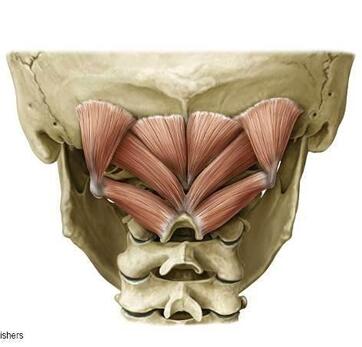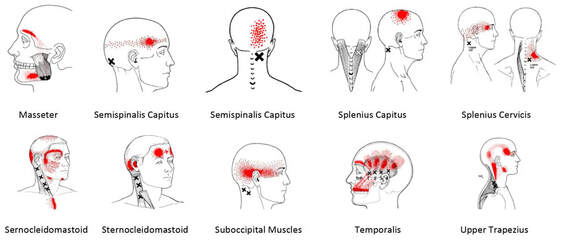|
This week's Muscle Monday is dedicated to the little group of muscles that often speak to us in times of stress. While there are MANY causes and types of headaches, it is estimated that 50% of all adults will experience a headache in the last year (Source: World Health Organization). Tension-Type headaches are the most common form of headaches, which can either be due to muscle tension as a result of stress or other musculoskeletal problems coming from the neck. With that being said, allow me to introduce our Fantastic Four, The Suboccipitals:
This group of muscles do not exert a significant amount of force to produce movement (you have much larger, stronger muscles for that). When they work together as a unit, they extend the head and/or generate a small amount of rotation of the head. What studies are now suggesting, is that instead of purely functioning as a skeletal muscle to produce movement, these muscles may ALSO be an integral part of cervical proprioception (that is, the awareness of your body in space) and the dynamic circulation of our cerebrospinal fluid (Source: Zheng N, Chung BS, et al., 2020) The Upper Trapezius (as we have previously discussed) and other muscles have been shown to be sources of referred pain in areas other than its originating location - otherwise known as "Trigger Points". The Suboccipitals are no different. Trigger points found among these muscles often refer pain or symptoms - such as: tightness, band-like, pressure, tension - into different areas of the head (X marks the spot). Trigger points almost always follow a certain pattern, which allows practitioners a way to help differentiate the sources of pain during their examination. As we mentioned earlier in this post, tension-type headaches are JUST ONE of many different types of headaches. So while it is very possible that these trigger points may be a source of your symptoms, if they are very severe or you have other symptoms associated with it, please be sure to check in with your friendly healthcare provider. As we've discussed in previous posts, these muscles have a tendency of adapting to become shorter/tighter if you are frequently in "bad postures" for long periods of time. As always, it's all about balance. These muscles almost never work in isolation, but need to be both strong and flexible at the same time to help the other neighboring muscles to do their job. Here are some simple ways to help your little suboccipital muscles stay nice and healthy. Until next time, do some diaphragmatic breathing, stretch out your neck, and take care of yourself. Stay happy and healthy!
|
AuthorDr. Janice Ying is a Los Angeles-based Physical Therapist. She is board-certified Orthopedic Physical Therapy Specialist and is regarded as a leading expert in the field of Performing Arts Medicine and the development of cutting edge injury prevention and rehabilitation programs for musicians. DisclaimerThe information on this website is intended for educational purposes and should NOT be construed as medical advice. If you have or think you have a health-related issue which needs to be addressed, please seek the help from your local licensed medical professional.
Archives
October 2020
Categories
All
|
We would love to see you soon!
|
© Opus Physical Therapy and Performance - 2021 - All Rights Reserved




 RSS Feed
RSS Feed